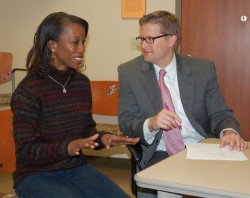When 55-year-old Neader Williams first learned that she might need spine surgery to treat her excruciating back and leg pain, she was more than a little scared and wasn’t even sure surgery was the answer.
But, after answering a few simple questions about her health history, Vanderbilt neurosurgeon Matthew McGirt, M.D., calculated that she had a 95 percent to 98 percent likelihood of a successful surgery.

“By looking at previous surgical outcomes of patients with similar age and weight, and also risk factors such as history of smoking or depression, we can more confidently recommend surgical treatment or even advise against it,” said McGirt, director of Clinical Spine Research at Vanderbilt and vice director of the National Neurosurgery Quality and Outcomes Database (N2QOD).
McGirt is leading a national effort, established by Neuropoint Alliance and the American Association of Neurological Surgeons, to better predict who will respond to surgery based on previous results and individual risk factors.
The new registry already includes surgical outcomes data from 175 surgeons representing 43 hospitals in 23 states, with information spanning the continuum of care from pre-operative, in-patient, and one-year postoperative outpatient care.
In its first year the group analyzed more than 3,500 lumbar surgery patients to determine the safety and cost-effectiveness of such procedures.
Cervical spine data will be collected this year, expanding enrollment to 10,000 patients per year.
“Before we had access to this information, spine surgery was recommended based on symptoms and what an MRI showed,” McGirt said. “But now, for the first time, we can know with greater certainty if surgery really is the best treatment option for each patient’s unique circumstance.”
The national database and registry, with Vanderbilt as its coordinating center, is expected to reduce health care costs by preventing ineffective or unnecessary surgeries, and by standardizing treatment in both the hospital and outpatient practice setting.
“This is the evolution of care,” said Vanderbilt’s Clint Devon, M.D., assistant professor of Orthopaedic Surgery and Rehabilitation. “There are plenty of registries that look at surgical safety data, but no other registry in the world incorporates patient-reported quality of life experiences that make it possible for patients to make more informed decisions about their own health care.”
McGirt believes the patient-centered approach will also change the way medical schools teach future surgeons.
“We now know with certainty that one pill or one surgery does not benefit all patients the same, even if patients have the same disease,” he said.
“So, teaching procedures is no longer enough. By teaching comparative effectiveness of actual patient experiences, our residents are learning how to analyze, interpret and predict patient treatment and care at the individual level.”












